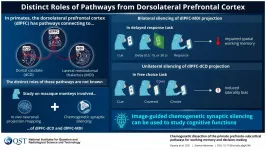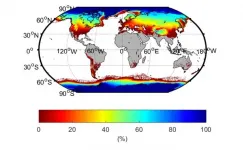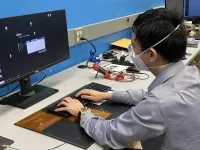(Press-News.org) The human brain is a wonderfully enigmatic organ, helping to juggle multiple tasks efficiently to help us get through a long day! This feature, called executive function, seats primates like us at the pinnacle of evolution. The prospect of losing the spectacular flow of neural information in our brains because of an accident or disease is, thus, unnerving. In the event of such an unfortunate occurrence, to restore the brain to its previous working condition with full functionality--to reboot it, so to speak--would need a better understanding of the specific neural pathways involved in our daily activities that rely on working memory and decision-making--two important executive functions.
To achieve this objective, a group of researchers from National Institutes for Quantum and Radiological Science and Technology (QST), Japan, were hard at work at devising a technique they call "imaging-guided chemogenetic synaptic silencing" to decipher the specific neural pathways involved in high-order executive functions. In a pioneering study published in Science Advances, the researchers now report successfully delineating specific neural pathways involved in working memory and decision-making using this technique.
The group, led by eminent researcher Dr. Takafumi Minamimoto from the Department of Functional Brain Imaging, QST, focused on studying the dorsolateral part of the prefrontal cortex (dlPFC) in the monkey brain, to apply their novel technique, and further identify the neural pathways of interest. It is interesting to note this choice, not only because it is the brain region partially responsible for controlling executive functions, but also since this specialized region is only present in primates.
Importantly, the role of dlPFC is supported by brain regions like the dorsal caudate (dCD) and lateral mediodorsal thalamus (MDl) too. This intricate association is further explained by Dr. Kei Oyama, who is the first author of the study, as follows, "The primate prefrontal cortex (PFC), especially its dorsolateral part (dlPFC), is well known to serve as the center of higher-order executive functions; it is uniquely developed in primates and underlies their distinctive cognitive abilities. These functions, however, do not solely rely on dlPFC neurons but also on their cooperative interactions with subcortical structures, including the dorsal caudate (dCD) nucleus and lateral mediodorsal thalamus (MDl)."
Next, the researchers wanted to understand the who-does-what for working memory and decision-making. Given that the dlPFC, MDI, and dCD neurons are connected, they selectively silenced specific neuronal synapses to disrupt the flow of information, and achieve just dlPFC-dCD and dlPFC-MDl projections, either unilaterally (involving just one side of the brain), or bilaterally (involving both sides). To achieve this, they made the dlPFC neurons express designer receptors exclusively activated by designer drugs (DREADDs). Further, the monkeys involved in the study were analyzed for behavioral changes, to understand the effect of chemogenetic silencing.
Interestingly, the researchers observed that silencing the bilateral dlPFC-MDl projections in the monkeys, but not their dlPFC-dCD projections, caused problems in the working memory related to their surroundings. On the contrary, silencing their unilateral dlPFC-dCD projections, but not their unilateral dlPFC-MDl projections, altered their preference in decision-making. These results reveal that the two higher-brain functions, working memory and decision-making, which are essential for our daily lives, are controlled by different neural pathways linking specific brain areas.
Overall, this study lays the foundation for further explorations of the intricacies of the complex primate brain. In this regard, Dr. Oyama explains the potential clinical and research applications of these findings, "Many psychiatric disorders, including depression, are thought to be associated with disturbances in the transmission of neural information through neural circuits between specific brain regions. Our findings are expected to deepen our understanding of mental disorders and lead to the discovery of treatments and remedies. The successful development of a novel technique in our study will serve as a key technology for the next-generation of researchers to investigate primate brain functions, which will contribute to broad areas in life by dramatically deepening our understanding of the mechanism of higher-brain functions."
The world will indeed wait with bated breath for future mysteries to unravel as explorations take researchers deeper into the labyrinthine maze that is the mind.
INFORMATION:
Research Article:
"Chemogenetic dissection of the primate prefronto-subcortical pathways for working memory and decision-making"
Kei Oyama, Yukiko Hori, Yuji Nagai, Naohisa Miyakawa, Koki Mimura, Toshiyuki Hirabayashi, Ken-ichi Inoue, Tetsuya Suhara, Masahiko Takada, Makoto Higuchi and Takafumi Minamimoto
Science Advances: June 23, 2021, DOI: https://doi.org/10.1126/sciadv.abg4246
About National Institutes for Quantum and Radiological Science and Technology:
The National Institutes for Quantum and Radiological Science and Technology (QST) was established in April 2016 to promote quantum science and technology in a comprehensive and integrated manner. QST's mission is to raise the level of quantum and radiological sciences and technologies through its commitment to research and development into quantum science and technology, the effect of radiation on humans, radiation emergency medicine, and the medical use of radiation. To ensure that research and development delivers significant academic, social and economic impacts, and to maximize benefits from global innovation, QST is striving to establish world-leading research and development platforms and explore new fields.
Website: https://www.qst.go.jp/site/qst-english/
About Dr. Kei Oyama from National Institutes for Quantum and Radiological Science and Technology, Japan:
Dr. Kei Oyama is a reputed researcher at the Department of Functional Brain Imaging. Specifically, Dr. Oyama is an active member of the Neural Systems and Circuits Research Group. He is an expert in different facets of behavioral and cognitive neuroscience, like learning and memory, behavior analyses, neuropharmacology, electrophysiology etc. His expertise is bolstered by around 20 publications in these fields, in reputed journals.
Funding information:
This study was funded by MEXT/JSPS KAKENHI grant numbers JP18K15353 and JP21K07268,
JP17H02219, JP19H05467, JP15H05917 and JP18H04037, JP18H05018, and JP19K07811; QST President's Strategic Grant (Creative Research); AMED grant numbers JP20dm0307007, JP20dm0307021, JP18dm0207003, and JP20dm0107146; JST PRESTO grant number JPMJPR1683; cooperative research program at PRI, Kyoto University; and National Bio-Resource Project "Japanese Monkeys" of MEXT, Japan
Media contact:
Public Relations Section
Department of Management and Planning, QST Tel: +81-43-206-3026 Email: info@qst.go.jp
Several cancer tumors grow through immunosuppression; that is, they manipulate biological systems in their microenvironments and signal to a specific set of immune cells--those that clear out aberrant cells--to stop acting. It is no wonder that immunotherapy designed to re-establish anti-tumor immunity is rapidly becoming the treatment of choice for these cancers.
One natural immunosuppressive molecule that falls prey to helping cancer tumors is indoleamine-2,3-dioxygenase 1 (henceforth, IDO1). Because it is found in a broad range of cancer tumors, including those of the skin, breast, colon, lung, and blood, scientists have begun to see it as a promising therapeutic target: Suppress its activity and anti-tumor immunity should be back. But all endeavors so far have ...
Researchers at the Francis Crick Institute and University of Dundee have screened thousands of drug and chemical molecules and identified a range of potential antivirals that could be developed into new treatments for COVID-19 or in preparation for future coronavirus outbreaks.
While COVID-19 vaccines are being rolled out, there are still few drug options that can be used to treat patients with the virus, to reduce symptoms and speed up recovery time. These treatments are especially important for groups where the vaccines are less effective, such as some patients with blood cancers.
In a series of seven papers, published today (2 July) in the Biochemical Journal, the scientists ...
Minority-ethnic medical students must have more role-models in senior leadership positions if they are to engage with academia. This is one of the conclusions drawn by a group of medical students writing in the Journal of the Royal Society of Medicine about the drivers and barriers to engaging with academia.
Barriers currently hampering the chances of minority-ethnic medical students accessing formal pathways into academia, they write, include differential attainment and unconscious bias, difficulties forming meaningful mentor-mentee relationships, as well as the ...
While autistic individuals are less likely to use substances, those who do so are more likely to self-medicate for their mental health symptoms, according to new research from the University of Cambridge and published today in The Lancet Psychiatry.
There is significant debate about substance use of autistic adolescents and adults. Some studies indicate that autistic individuals are less likely to use substances, whereas others suggest that autistic individuals are at greater risk of substance misuse or abuse. The team at the Autism Research Centre in Cambridge used a 'mixed methods' design to consider ...
In an article appearing in Nature Biomedical Engineering, a team of scientists from the UCLA David Geffen School of Medicine and UCLA School of Engineering report real-world results on SwabSeq, a high-throughput testing platform that uses sequencing to test thousands of samples at a time to detect COVID-19. They were able to perform more than 80,000 tests in less than two months, with the test showing extremely high sensitivity and specificity.
SwabSeq uses sample-specific molecular barcodes to simultaneously analyze thousands of samples for the presence or absence of SARS-CoV-2, the virus that causes COVID-19. SwabSeq was granted FDA Emergency Use Authorization in October ...
Cash in on the kids' inheritance and spend up big on the retirement plans - that's the message coming from the University of South Australia as new research reveals that older people are keen to spend their well-earned savings, rather than passing them on to their kids.
And while it may seem like bad news for the younger generation, the research also confirms that the kids are just fine with this scenario, claiming that no one owes anyone anything.
The surprising findings are part of a new study that explores contemporary attitudes towards wealth ...
LA JOLLA, CA--Researchers at La Jolla Institute for Immunology (LJI) have found that T cells from people who have recovered from COVID-19 or received the Moderna or Pfizer-BioNTech vaccines are still able to recognize several concerning SARS-CoV-2 variants.
Their new study, published online on July 1, 2021 in Cell Reports Medicine, shows that both CD4+ "helper" T cells and CD8+ "killer" T cells can still recognize mutated forms of the virus. This reactivity is key to the body's complex immune response to the virus, which allows the body to kill infected cells and stop severe infections.
"This study suggests that the impact of mutations ...
WASHINGTON--The global cryosphere--all of the areas with frozen water on Earth--shrank by about 87,000 square kilometers (about 33,000 square miles), a area about the size of Lake Superior, per year on average, between 1979 and 2016 as a result of climate change, according to a new study. This research is the first to make a global estimate of the surface area of the Earth covered by sea ice, snow cover and frozen ground.
The extent of land covered by frozen water is just as important as its mass because the bright white surface reflects sunlight so effectively, cooling the planet. Changes in the size or location of ice and snow can alter air temperatures, change the sea level and even affect ocean currents worldwide.
The new study is published in Earth's ...
People lived without plastic until the last century or so, but most of us would find it hard to imagine how.
Plastics now are everywhere in our lives, providing low-cost convenience and other benefits in countless applications. They can be shaped to almost any task, from wispy films to squishy children's toys and hard-core components. They have shown themselves vital in medicine and have been pivotal in the global effort to slow the spread of the COVID-19 pandemic over the past 16 months.
Plastics seem indispensable these days.
Unfortunately for the long-term, they are also nearly indestructible. Our planet now bears the weight of more than seven billion tons ...
As smart watches are increasingly able to monitor the vital signs of health, including what's going on when we sleep, a problem has emerged: those wearable, wireless devices are often disconnected from our body overnight, being charged at the bedside.
"Quality of sleep and its patterns contain a lot of important information about patients' health conditions," says Sunghoon Ivan Lee, assistant professor in the University of Massachusetts Amherst College of Information and Computer Sciences and director of the Advanced Human Health Analytics Laboratory.
But that information can't be tracked on smartwatches if the wearable devices are ...




